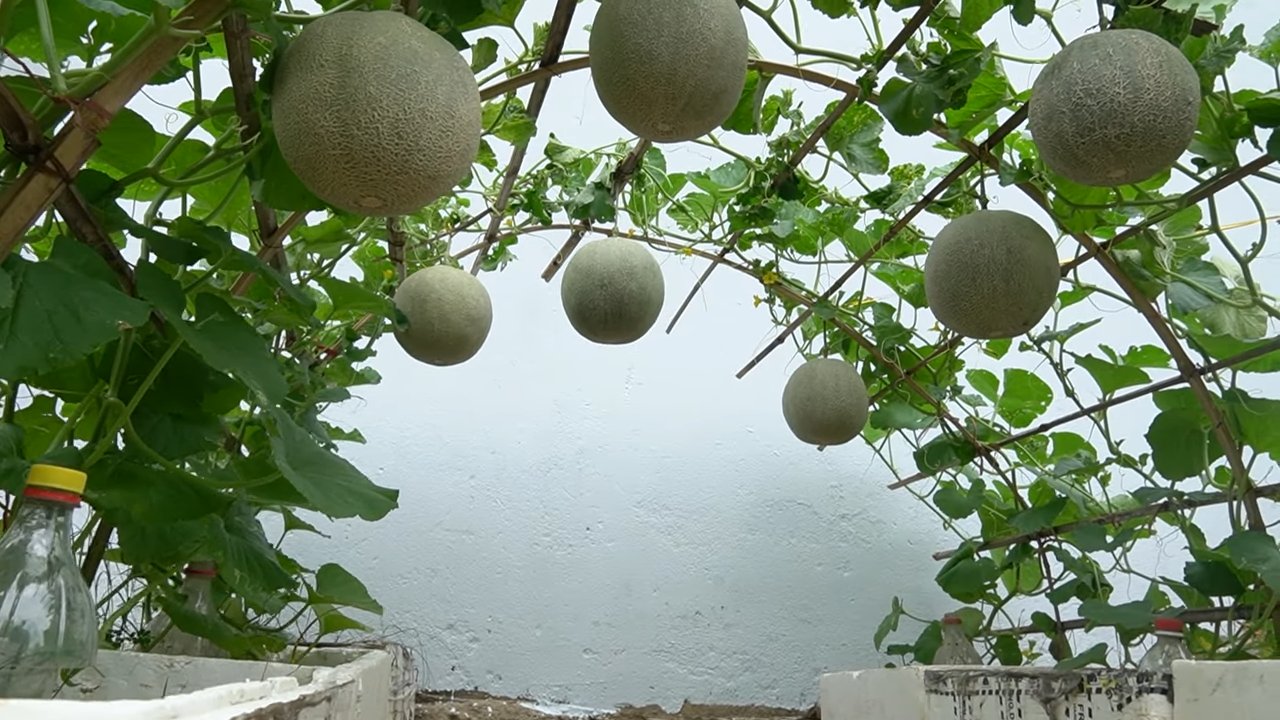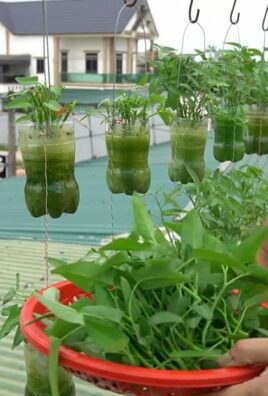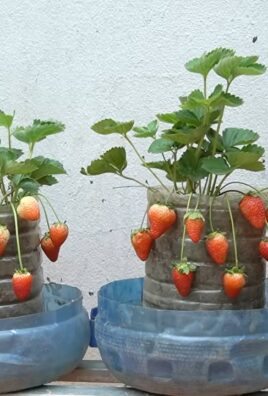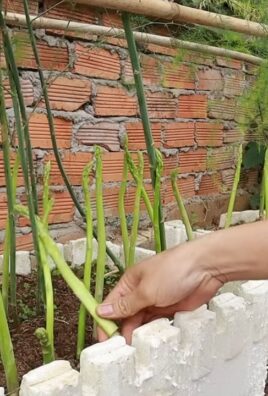Grow Cantaloupe Successfully, even if you think you don’t have a green thumb! Have you ever bitten into a perfectly ripe, juicy cantaloupe and thought, “I wish I could grow these myself?” Well, you absolutely can! Forget those bland, store-bought melons – imagine the satisfaction of harvesting your own sweet, fragrant cantaloupe right from your backyard. This DIY guide is packed with simple tricks and hacks to help you cultivate thriving cantaloupe vines, no matter your gardening experience.
Cantaloupe, with its vibrant orange flesh and refreshing taste, has a rich history. Originating in Africa and India, it has been cultivated for centuries, eventually making its way to Europe and the Americas. For generations, gardeners have passed down secrets for nurturing these sun-loving fruits. Now, I’m sharing those secrets with you!
Why do you need these DIY tricks? Because growing cantaloupe can be a bit tricky! They require specific conditions to flourish, and without the right knowledge, you might end up with small, tasteless fruits or even a failed harvest. But don’t worry, I’m here to help you avoid those pitfalls. I will show you how to grow cantaloupe successfully, from choosing the right variety to protecting your plants from pests and diseases. Get ready to enjoy the sweet taste of homegrown cantaloupe this season!

Growing Cantaloupe: Your DIY Guide for a Sweet Harvest
Hey garden friends! Cantaloupe melons are simply delicious, and there’s nothing better than growing them yourself. I’ll show you how to achieve a bountiful harvest with a little patience and the right tricks. Don’t worry, it’s easier than you think!
What You Need for Growing Cantaloupe:
- Cantaloupe seeds: Choose a variety that is suitable for your climate. Check at a specialty store or online.
- Seedling pots or trays: For starting indoors.
- Seed starting mix: Special soil for seedlings that contains fewer nutrients.
- Garden soil: Well-draining, nutrient-rich soil for the garden bed.
- Compost or organic fertilizer: To enrich the soil.
- Mulch: Straw, wood chips, or similar materials to retain moisture in the soil and suppress weeds.
- Watering can or garden hose: For watering.
- Stakes or trellis (optional): For varieties that climb.
- Garden fleece (optional): For protection against cold and pests in the first few weeks.
- Patience and love: The most important things!
Phase 1: Starting Indoors (approx. 4-6 weeks before the last frost)
If you live in a region with short summers, I strongly recommend starting your cantaloupe seeds indoors. This gives the plants a head start and extends the ripening period.
- Prepare seeds: You can soak the seeds in lukewarm water for 24 hours before sowing. This speeds up germination. I usually do this, but it also works without.
- Sow in seedling pots: Fill the seedling pots with seed starting mix. Press the soil down lightly and sow 2-3 seeds per pot about 1-2 cm deep. Cover the seeds with soil and water them gently.
- The right location: Place the seedling pots in a warm, bright place. A south-facing windowsill is ideal. The germination temperature should be between 20 and 25 degrees Celsius.
- Maintain moisture: Keep the soil moist, but not wet. It’s best to spray the soil regularly with a spray bottle. Avoid waterlogging, as the seeds can rot.
- Wait for germination: Germination usually takes 7-14 days. As soon as the first seedlings appear, you can remove the weakest seedling from each pot.
- Care for the young plants: Water the young plants regularly and turn the pots occasionally so they grow evenly. If the plants become too crowded, you can transplant them into larger pots.
Phase 2: Preparing the Bed
Cantaloupe melons love the sun and a well-prepared soil.
- The right location: Choose a sunny spot with at least 6-8 hours of direct sunlight per day.
- Prepare the soil: Loosen the soil thoroughly and remove weeds and stones. Cantaloupe melons prefer a well-draining, nutrient-rich soil with a pH between 6.0 and 6.8.
- Enrich the soil: Work in plenty of compost or organic fertilizer. This improves the soil structure and provides the plants with important nutrients. I always use a good portion of compost, my melons love it!
- Create a mound (optional): In cooler regions, it can be useful to create a mound. This warms the soil faster and improves drainage.
Phase 3: Planting Out the Young Plants
Once there is no more danger of frost (mid-May in most regions) and the young plants are strong enough, they can be planted outdoors.
- Harden off the young plants: Before you plant the young plants outdoors, you should harden them off for a few days. Place them outside for a few hours during the day and bring them back in at night. This acclimates them to the changing conditions.
- Planting distance: Plant the young plants about 60-90 cm apart. If you are planting in rows, the rows should be about 1.5 meters apart.
- Planting: Dig a hole that is slightly larger than the root ball of the young plant. Carefully place the plant in the hole, fill it with soil, press the soil down lightly, and water the plant thoroughly.
- Mulching: Apply a layer of mulch around the plants. This retains moisture in the soil, suppresses weeds, and protects the fruit from direct contact with the ground.
- Protection from cold (optional): In the first few weeks after planting, you can protect the plants with garden fleece to shield them from cold and pests.
Phase 4: Caring for the Cantaloupe Plants
Regular care is important for a bountiful harvest.
- Watering: Water the plants regularly, especially during fruit development. Avoid wetting the leaves, as this can promote fungal diseases. It’s best to water in the morning so the leaves can dry during the day.
- Fertilizing: Fertilize the plants every 2-3 weeks with an organic fertilizer or compost tea. Make sure the fertilizer is rich in potassium, as this promotes fruit development.
- Weed control: Remove weeds regularly to avoid competition for the plants.
- Pest control: Check the plants regularly for pests like aphids or slugs. If necessary, you can use organic pesticides.
- Trellis (optional): If you are growing a climbing variety, you should provide the plants with a trellis. This makes harvesting easier and prevents the fruit from lying on the ground.
- Pruning (optional): You can prune the plants to encourage fruit development. To do this, remove side shoots that are not bearing flowers.
Phase 5: The Harvest
Harvest time is the best part!
- Recognizing ripeness: Cantaloupe melons are ripe when they have a sweet fragrance and detach easily from the stem. The rind should turn slightly yellowish and the netting should be clearly defined.
- Harvesting: Carefully cut the melon from the stem.
- Storage: Ripe cantaloupe melons can be stored in the refrigerator for a few days.
Additional Tips for a Successful Harvest:
- Pollination: Cantaloupe melons rely on pollination by bees and other insects. If you have few insects in your garden, you can hand-pollinate the flowers.
- Promote fruit set: Remove the first flowers to strengthen the plant and encourage fruit development.
- Protection from sunburn: In very hot regions, the fruit can get sunburned. Protect them with a cloth or shade net if necessary.
- Observation: Observe your plants regularly and react quickly to problems such as diseases or pests.
I hope this guide helps you achieve a bountiful cantaloupe harvest. Happy gardening! And remember: patience is key.

Conclusion
So, there you have it! Mastering the art of growing cantaloupe successfully doesn’t require a green thumb blessed by the gardening gods. It’s about understanding the plant’s needs, providing the right environment, and employing a few clever techniques to maximize your yield. From selecting the perfect sunny spot to hand-pollinating your precious blossoms, each step contributes to the sweet, juicy reward that awaits.
Why is this DIY approach a must-try? Because it empowers you to take control of your food source, enjoy the satisfaction of nurturing life from seed to fruit, and savor the unparalleled flavor of homegrown cantaloupe. Store-bought cantaloupe simply can’t compare to the vibrant taste and texture of a melon ripened under your own care. Plus, you’ll avoid the pesticides and preservatives often found in commercially grown produce.
But the journey doesn’t end here! Feel free to experiment with different varieties of cantaloupe to discover your personal favorite. Try growing them in raised beds for improved drainage, or consider companion planting with herbs like basil or marigolds to deter pests naturally. If you live in a cooler climate, starting your seeds indoors and using row covers can extend your growing season and protect your plants from frost. You can even try vertical gardening techniques to save space and add a unique aesthetic to your garden.
Don’t be afraid to get your hands dirty and embrace the learning process. Gardening is a journey of discovery, and every season brings new challenges and opportunities. The key is to observe your plants closely, adapt to their needs, and never stop learning.
We wholeheartedly encourage you to embark on this cantaloupe-growing adventure. Imagine the pride you’ll feel when you harvest your first perfectly ripe melon, knowing that you nurtured it from a tiny seed to a delicious, healthy fruit. Share your experiences with us! We’d love to hear about your successes, your challenges, and any unique techniques you discover along the way. Post pictures of your cantaloupe plants, share your favorite recipes using homegrown cantaloupe, and let’s create a community of passionate gardeners who are dedicated to growing cantaloupe successfully.
So, grab your seeds, prepare your soil, and get ready to experience the joy of growing your own cantaloupe. You won’t regret it! The taste of success, and the sweet flavor of homegrown cantaloupe, is waiting for you.
Frequently Asked Questions (FAQ)
What is the best time to plant cantaloupe seeds?
Cantaloupe thrives in warm weather, so the best time to plant seeds is after the last frost when the soil temperature has reached at least 65°F (18°C). In most regions, this is typically in late spring or early summer. You can start seeds indoors 3-4 weeks before the last frost to get a head start, but be sure to harden off the seedlings before transplanting them outdoors. Starting indoors gives you a jump start on growing cantaloupe successfully.
How much sunlight does cantaloupe need?
Cantaloupe requires at least 6-8 hours of direct sunlight per day to thrive. Choose a sunny location in your garden where the plants will receive ample sunlight throughout the day. Insufficient sunlight can lead to stunted growth, poor fruit production, and bland-tasting melons.
What type of soil is best for growing cantaloupe?
Cantaloupe prefers well-drained, fertile soil that is rich in organic matter. The ideal soil pH is between 6.0 and 6.8. Before planting, amend the soil with compost or well-rotted manure to improve its fertility and drainage. Avoid heavy clay soils, as they can retain too much moisture and lead to root rot.
How often should I water cantaloupe plants?
Cantaloupe plants need consistent moisture, especially during fruit development. Water deeply and regularly, aiming to keep the soil consistently moist but not waterlogged. Avoid overhead watering, as it can promote fungal diseases. Drip irrigation or soaker hoses are ideal for delivering water directly to the roots. Reduce watering as the fruits ripen to prevent them from splitting.
How do I know when a cantaloupe is ripe?
There are several indicators that a cantaloupe is ripe. The skin will change color from green to a tan or yellowish hue. The stem will begin to crack and separate easily from the vine. The melon will also have a sweet, fragrant aroma. Gently press on the blossom end (opposite the stem end) – it should feel slightly soft and yield to gentle pressure.
What are some common pests and diseases that affect cantaloupe?
Common pests that can affect cantaloupe include aphids, squash bugs, cucumber beetles, and vine borers. Diseases include powdery mildew, downy mildew, and fusarium wilt. Monitor your plants regularly for signs of pests or diseases and take appropriate action, such as using insecticidal soap, neem oil, or fungicides. Good air circulation and proper watering practices can help prevent many diseases.
Do I need to prune cantaloupe plants?
Pruning cantaloupe plants is not essential, but it can improve air circulation and fruit production. Remove any yellowing or diseased leaves, as well as any non-productive vines. You can also pinch off the tips of the vines to encourage branching and more fruit development.
How can I improve pollination of my cantaloupe plants?
Cantaloupe plants rely on bees and other pollinators to transfer pollen from the male flowers to the female flowers. If you notice a lack of bee activity in your garden, you can hand-pollinate the flowers yourself. Use a small paintbrush to collect pollen from the male flowers (which have a long, thin stem) and transfer it to the female flowers (which have a small fruit at the base). Do this in the morning when the flowers are open.
Can I grow cantaloupe in containers?
Yes, you can grow cantaloupe in containers, but you’ll need a large container (at least 20 gallons) with good drainage. Choose a dwarf or bush variety of cantaloupe that is better suited for container growing. Provide adequate sunlight, water, and fertilizer, and consider using a trellis to support the vines.
What are some good companion plants for cantaloupe?
Good companion plants for cantaloupe include marigolds, basil, oregano, and nasturtiums. Marigolds and nasturtiums deter pests, while basil and oregano can improve the flavor of the melons. Avoid planting cantaloupe near potatoes or other members of the nightshade family, as they can compete for nutrients.
How do I store cantaloupe after harvesting?
Store ripe cantaloupe in the refrigerator for up to 5 days. Cut cantaloupe should be stored in an airtight container to prevent it from drying out. You can also freeze cantaloupe chunks for later use in smoothies or desserts.
What fertilizer should I use for cantaloupe?
Use a balanced fertilizer (e.g., 10-10-10) at planting time, and then side-dress with a nitrogen-rich fertilizer (e.g., ammonium nitrate) when the vines begin to run. Avoid over-fertilizing, as this can lead to excessive foliage growth and reduced fruit production.
How can I prevent my cantaloupe from cracking?
Cracking can occur when the fruits ripen rapidly after a period of drought or inconsistent watering. To prevent cracking, water your plants consistently and avoid letting the soil dry out completely. You can also mulch around the plants to help retain moisture.
What are some different varieties of cantaloupe I can try?
There are many different varieties of cantaloupe to choose from, each with its own unique flavor and characteristics. Some popular varieties include Hale’s Best Jumbo, Athena, Ambrosia, and Honey Rock. Experiment with different varieties to find your personal favorite.
How long does it take for cantaloupe to mature?
Cantaloupe typically takes 70-90 days to mature from seed to harvest. The exact time will depend on the variety, growing conditions, and climate. Be patient and monitor your plants closely for signs of ripeness.




Leave a Comment